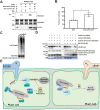Combination of in vivo proximity labeling and co-immunoprecipitation identifies the host target network of a tumor-inducing effector in the fungal maize pathogen Ustilago maydis
- PMID: 37225161
- PMCID: PMC10433927
- DOI: 10.1093/jxb/erad188
Combination of in vivo proximity labeling and co-immunoprecipitation identifies the host target network of a tumor-inducing effector in the fungal maize pathogen Ustilago maydis
Abstract
Plant pathogens secrete effectors, which target host proteins to facilitate infection. The Ustilago maydis effector UmSee1 is required for tumor formation in the leaf during infection of maize. UmSee1 interacts with maize SGT1 (suppressor of G2 allele of skp1) and blocks its phosphorylation in vivo. In the absence of UmSee1, U. maydis cannot trigger tumor formation in the bundle sheath. However, it remains unclear which host processes are manipulated by UmSee1 and the UmSee1-SGT1 interaction to cause the observed phenotype. Proximity-dependent protein labeling involving the turbo biotin ligase tag (TurboID) for proximal labeling of proteins is a powerful tool for identifying the protein interactome. We have generated transgenic U. maydis that secretes biotin ligase-fused See1 effector (UmSee1-TurboID-3HA) directly into maize cells. This approach, in combination with conventional co-immunoprecipitation, allowed the identification of additional UmSee1 interactors in maize cells. Collectively, our data identified three ubiquitin-proteasome pathway-related proteins (ZmSIP1, ZmSIP2, and ZmSIP3) that either interact with or are close to UmSee1 during host infection of maize with U. maydis. ZmSIP3 represents a cell cycle regulator whose degradation appears to be promoted in the presence of UmSee1. Our data provide a possible explanation of the requirement for UmSee1 in tumor formation during U. maydis-Zea mays interaction.
Keywords: Ustilago maydis; Fungal effectors; TurboID; maize; protein interactome; ubiquitin–proteasome.
© The Author(s) 2023. Published by Oxford University Press on behalf of the Society for Experimental Biology.
Conflict of interest statement
The authors declare no conflicts of interest.
Figures





References
-
- Bashir T, Dorrello NV, Amador V, Guardavaccaro D, Pagano M.. 2004. Control of the SCFSkp2–Cks1 ubiquitin ligase by the APC/CCdh1 ubiquitin ligase. Nature 428, 190–193. - PubMed
-
- Bindics J, Khan M, Uhse S, et al. . 2022. Many ways to TOPLESS—manipulation of plant auxin signalling by a cluster of fungal effectors. New Phytologist 236, 1455–1470. - PubMed
Publication types
MeSH terms
Substances
Supplementary concepts
LinkOut - more resources
Full Text Sources
Medical

